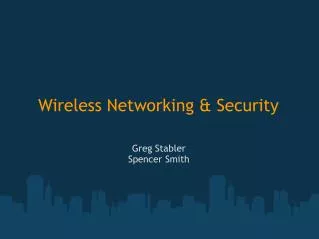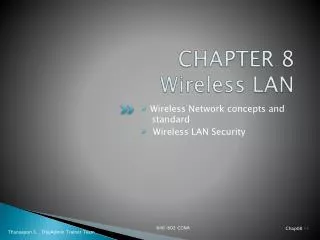
Chapter 24 : Wireless Network Security. Wireless Security Overview. concerns for wireless security are similar to those found in a wired environment security requirements are the same: confidentiality, integrity, availability, authenticity, accountability

dalmar + Follow
Download PresentationAn Image/Link below is provided (as is) to download presentation Download Policy: Content on the Website is provided to you AS IS for your information and personal use and may not be sold / licensed / shared on other websites without getting consent from its author. Content is provided to you AS IS for your information and personal use only. Download presentation by click this link. While downloading, if for some reason you are not able to download a presentation, the publisher may have deleted the file from their server. During download, if you can't get a presentation, the file might be deleted by the publisher.

Chapter goals: understand principles of network security: cryptography and its many uses beyond “confidentiality” authentication message integrity key distribution security in practice: firewalls security in application, transport, network, link layers. Chapter 8: Network Security.
1.62k views • 84 slides

Chapter 9. Wireless network. Wireless Network. In wireless network, data are carried by electrical wave (e.g., radio wave ) from one node to another. There is no physical cable/wire connecting one computer to another. Wired (Cabled) Network versus Wireless Network.
718 views • 32 slides

Wireless Sensor Network Security. Anuj Nagar CS 590. Introduction. Typical Wireless Sensor Network (WSN). Need for security. WSNs are becoming a cost effective, practical way to go about deploying sensor networks.
631 views • 16 slides

Chapter 18: Network Security. Business Data Communications, 5e. Types of Security. Information Security Computer Security Network Security. Security Requirements. Confidentiality Integrity Availability Authenticity. Security Threats. Passive attacks Release of message contents
935 views • 36 slides

Wireless Networking & Security. Greg Stabler Spencer Smith. Preview. Brief History of Wireless networking Types of Wireless Security Unsecured WEP WPA WPA2 Why use wireless encryption? Additional Security Measures for your router What to do if on an unsecured network.
406 views • 12 slides

Introduction to Wireless Security Lecture 10. Outline. The importance of Wireless communications Wireless networks and security risks Why is it so hard to secure wireless communications? Wireless communications and network security issues WEP WAP Bluetooth (reading)
793 views • 38 slides

ECE 454 / CS 594 Computer and Network Security. Dr. Jinyuan (Stella) Sun Dept. of Electrical Engineering and Computer Science University of Tennessee Fall 2011. 1. Wireless Security 1 --Cellular Networks. Outline. Wireless networks Wireless security challenges GSM security
893 views • 70 slides

Local Wireless Network. - An wireless Access Point (AP) which is the bridge the ethernet network and the wireless network -The AP protect its wireless network from unauthorized users with different security protocols .
367 views • 14 slides

Telecommunications and Network Security. CISSP Guide to Security Essentials Chapter 10. Objectives. Wireline and wireless telecommunication technologies Wired and wireless network technologies Network topologies and cabling The OSI and TCP/IP network models. Objectives (cont.).
1.43k views • 119 slides

Wireless Network Security Comparison of WEP, WPA, RSN Protocols. By Rajanikanth Ragula CS Login: rragula. Introduction . Wireless LAN’s becoming popular. Fast, cost effective and flexible. Security became a critical issue. Wired Vs Wireless .
573 views • 25 slides

FORE SEC Academy Security Essentials. Wireless Network Security. Objectives. Learn how wireless networks are used Wireless architecture and protocols Common misconceptions Top 5 security risks Steps to planning a secure WLAN. Popular Wireless Devices.
1.79k views • 19 slides

CHAPTER 8 Wireless LAN. Wireless Network concepts and standard Wireless LAN Security. Chapter Objective. On completion of this chapter, you will be able to perform the following tasks: Understand Wireless network concepts Understand Wireless LAN standard (IEEE802.11)
322 views • 12 slides

Wireless LAN (network) security. Wireless security. - Is the process of preventing unauthorized access or damage to computers (damage data or damage application) using wireless network . - WLAN vulnerabilities: 1- Weak device – only authentication 2- Weak data encryption
286 views • 11 slides

Cryptography and Network Security Chapter 17. Fifth Edition by William Stallings Lecture slides by Lawrie Brown. Chapter 17 – Wireless Network Security.
607 views • 37 slides

Chapter goals: Understand principles of network security: cryptography and its many uses beyond “confidentiality” authentication message integrity key distribution security in practice: firewalls security in applications Internet spam, viruses, and worms. Chapter 8: Network Security.
666 views • 37 slides

Chapter 18: Security in Wireless Networks and Devices. Guide to Computer Network Security. Wireless technology is a new technology that started in the early 1970s.
367 views • 23 slides

Hacking 802.11 Wireless. Prabhaker Mateti Wright State University. Talk Outline. Wireless LAN Overview Wireless Network Sniffing Wireless Spoofing Wireless Network Probing AP Weaknesses Denial of Service Man-in-the-Middle Attacks War Driving Wireless Security Best Practices Conclusion.
2.82k views • 232 slides

Wireless Network Security By Patrick Yount and. CIS 4360 Fall 2009. Taking Steps Towards a Wireless World. What is a Wireless Network?. A group of connected devices that communicate through the air by means of electromagnetic waves, such as radio waves. Types of Wireless Networks.
344 views • 16 slides

CWSP Guide to Wireless Security. Chapter 7 Designing a Secure Wireless Network. Objectives. Describe the basic principles of security design Define network segmentation and tell how it can be used for WLANs List ways in which wireless hardware can be located securely
807 views • 57 slides

Chapter goals: understand principles of network security: cryptography and its many uses beyond “confidentiality” authentication message integrity key distribution security in practice: firewalls security in application, transport, network, link layers. Chapter 8: Network Security.
1.3k views • 88 slides

Network Security Essentials Chapter 6. Fourth Edition by William Stallings Lecture slides by Lawrie Brown. Chapter 6 – Wireless Network Security.
686 views • 37 slides

Wireless Security. by: Frank Pfleger. Overview. Introduction to Wireless Networks Secure the Network Wireless Security Mechanisms Unsecure the Network Security Mechanism Weaknesses Tools and Techniques Wardriving / Procedures. Introduction. Private Wi-Fi
506 views • 22 slides